What Happens If You Unplug Idle Air Control Valve [2024] – My Personal Experience

Hi there, I’m Isaac V. Mace, founder of Phoenix Car Mag. Car owners ask me lots of questions about idle air control valves (IACV) in cars.
This component plays a crucial role in managing the car’s idle speed. It also provides a smooth performance.
Now the question is: what happens to the car if we unplug the idle air control valve? It causes some problems in the car’s engine performance. The engine will be unable to provide a stable idle, and this leads to erratic behavior or stalling. Furthermore, the balance of the engine’s air-fuel mixture will be damaged.
All of these issues indicate the importance of the idle air control valve’s presence in the vehicle.
You might also enjoy: Car Sputters After Getting Gas: Top 10 Causes And Solutions
5 Consequences of Unplugging the Idle Air Control Valve: My Personal Experience
As a result of unplugging the idle air control valve, you will face significant problems and unusual behaviors in your car.
I’m quite experienced in this field, so here are 5 most important consequences:
1. Engine Stalling and Irregular Idling
As soon as you unplug the idle air control valve, you’ll see significant changes in the engine’s idle behavior.
The engine will be unable to maintain a stable idle speed.
This causes erratic idling or stalling.
In some cars like the 1991 Honda Civic, the slowdown to idle speed was much more significant. However, it didn’t damage the engine.
In brief, the engine can keep running even without the idle air control valve, but it can no longer maintain a stable idle speed.
2. Fluctuating Engine Revs
If the IACV is unplugged, you will see fluctuation in the engine’s revs.
This issue is more noticeable in vehicles in which the IACV has the role of idle regulation during the vehicle’s temperature switch.
If the IACV fails, you will see Rev fluctuation.
This fluctuation will compromise the engine’s consistent performance.
3. Compromised Cold Start Performance
The idle air control valve has an important role during cold starts.
This component will regulate the engine’s idle speed until it warms up.
If the IACV doesn’t work properly, the engine can not maintain a stable idle during cold starts.
As a result of this, the car may stall or run roughly until the engine warms up and reaches the ideal temperature.
This issue is observed in some vehicles discussed on the Third Generation F-Body Message Boards.
4. Increased Fuel Consumption
A failing idle air control valve will cause the engine’s inefficiencies.
The engine tries to compensate for the insufficient air supply by consuming more fuel than usual.
This issue will both affect your car’s engine health and annoy you by paying more money for fuel.
5. Potential Damage to Engine Components
Disconnection of the IACV will damage other engine components over time.
When the IACV is disconnected, the engine has to operate higher than its parameters to compensate for this absence.
This will quicken the corrosion of components like spark plugs, the throttle body, and the engine’s internal parts. In the car forums, people discuss the long-term impacts of a failing idle air control valve.
As a result, the IACV has a significant impact on the engine’s smooth performance and idle.
It even has a more important role during cold starts.
The side effects of this issue range from a minor problem of rough idling to serious ones like increased Fuel consumption or severe engine damage.
If you ask me, I suggest you stick to regular IACV chs, it enables you to address its potential issues promptly and prevent major problems and damages.
In this way, you can not only ensure your car’s longevity but also prevent problems and keep your car’s smooth performance.
You might also enjoy: How Many Brake Pads Come In A Box? [2023]
Can I drive with a failing idle air control valve?
It’s not an impossible action, but I don’t recommend you.
It’s not wise, because it may lead to more serious damages and potential risks.
The IACV manages your vehicle’s idle speed and ensures its smooth performance during idle or low-speed conditions.
How do I know if my idle air control valve is stuck?
I’m going to introduce these five steps to find this out:
1. Check Engine Light and Error Codes
If the IACV is stuck, the check engine light will be illuminated.
You should use an OBD2 scanner and look for relevant error codes, like P0505, P0506, P0507, P0508, and P0509. These codes relate to IACV issues.
2. Observe Idle Behavior
We will have Irregular Idling as a result of a stuck IACV. In this case, the idle speed is either too high or too low.
If you see noticeable RPM fluctuation or erratic idle, the IACV doesn’t regulate the airflow properly.
You might also enjoy: Can A Weak Alternator Cause Poor Engine Performance? 2023 Answer
3. Engine Stalling During Idle
The engine stalling during idle or cold starts indicates the stuck IACV.
The valve maintains the engine idle under different conditions.
If it’s stuck, it can’t provide the proper idle speed.
4. Performance Issues During Cold Start
You can find out that your IACV is stuck as a result of facing difficulties if the engine starts in cold conditions.
The idle air control valve regulates the engine’s air-fuel mixture in cold conditions.
So if it sticks, this process won’t be done properly and we will face starting issues.
5. Physical Inspection
If you are familiar with basic car maintenance, you can easily find and inspect the idle air control valve physically.
It’s often located on the throttle body or next to it.
You should check for obvious physical signs of sticking. These signs can be dirt and carbon buildup.
They can disrupt the valve’s movement.
You might also enjoy: 10 Key Differences between 4.3 and 4.3 Vortec [2023]
How much does it cost to fix an idle air control valve?
The cost of an idle air control valve is various and depends on your area’s labor charges, your car’s model, and the cost of parts.
But this is a general guidance:
1. Cost of the IACV
You can buy a new idle air control valve by paying from $50 to $200.
This price difference is due to the car’s make, model, and the valve’s specific design.
You may pay more for less common or high-end vehicles.
2. Labor Costs
The labor cost of replacing an IACV is various and depends on your geographic location and mechanic.
But it costs between $50 to $150.
Remember that the consumed time for valve replacement can also change the price.
Typically, valve replacement is not a complex process and doesn’t take much time, but it also depends on your engine’s complexity.
3. Additional Costs
Your total cost will be increased if the idle air control valve has damaged another component or if it’s also needed to clean the throttle body.
Also, you can take and advantage of this situation and address maintenance issues. This will save you time and money in the long run.
4. Diagnostic Fee
If you are not sure if your IACV is failing or not, you can take a diagnostic test to make sure.
The cost of this test varies in different help centers, it ranges between $500 to $100.
However, if you fix the mentioned issue at the same store, they won’t charge you for the diagnostic test.
5. Geographical Variations
Labor costs are highly dependent on your living area.
For instance, the cost of living is higher in urban areas; so the automotive repair services will be more expensive.
In short, you should pay something better $100 to $350 to replace your idle air control valve.
It’s wise to browse some repair shops and consult with different mechanics to find your most suitable option.
But keep in mind that choosing the cheapest option is not always the best one.
The quality of components and the skill of the mechanic are different.
You might also enjoy: 8 Ways to Stop Brakes From Squeaking Without Taking Tire Off? [2023]
Preventive Measures and Maintenance: My Personal 7 Tips
1. Regular Cleaning
The idle air control valve should be frequently cleaned. If it’s not, we will face carbon buildup that limits the valve’s operation.
2. Check Electrical Connections
Check the electrical connections to the IACV to make sure they’re secured and free from corrosion.
3. Monitor Idle Behavior
You should be attentive to your vehicle’s idle behavior. If you address the idling issues promptly, you can prevent more severe damage.
4. Replace Aging Components
You should replace old components in your maintenance routines. It’s a more important job to do for older vehicles.
5. Use Quality Fuel
Use high-quality fuel to avoid deposits buildup like carbon buildup in both the engine and IACV.
6. Regular Engine Check-ups
Consider checking your IACV in regular maintenance checks.
7. Stay Informed
Stay updated about your vehicle’s special maintenance suggestions about the IACV.
You might also enjoy: Mitsubishi Outlander PHEV Problems – [2023 Update]
Conclusion
In conclusion, the idle air control valve plays a crucial role in maintaining your car’s health and longevity. Some unplug it because you will face major problems. It’s necessary to check it regularly and address potential issues immediately.
FAQs
What are the common symptoms of a failing idle air control valve?
- I’m a specialist in this field and as far as I know, common signs of a failing IACV are engine stalling, erratic idling speed in the car’s cold conditions, and sometimes a triggered check engine light. Furthermore, the decreased efficiency of fuel and engine performance should be noticeable.
How urgent is it to replace a faulty idle air control valve?
- The faulty IACV requires immediate attention and you should replace it urgently. You can indeed drive your car in this situation; but it’s dangerous due to its erratic idle and stalling, especially in traffic. Also, a faulty IACV causes excessive fuel consumption and more damage to the engine.
Can a bad idle air control valve cause starting problems?
- Absolutely! It leads to starting problems, and these problems will be more serious in cold conditions. The valve regulates the air-fuel mixture during the idling. If it doesn’t operate properly, the engine can’t maintain the necessary idle speed to start and run smoothly.
Is it possible to clean an idle air control valve instead of replacing it?
- It works in many cases. Especially if the problem is due to dirt or carbon buildup. However, you should consider replacing the valve if it’s damaged severely. Because in these cases cleaning the valve can not resolve the issue.
What impact does a malfunctioning idle air control valve have on fuel efficiency?
- If the IACV fails, we face poor fuel efficiency. The engine is forced to use more fuel than usual to compensate for the insufficient air supply. This leads to higher m costs as a result of higher fuel consumption.
How does a faulty idle air control valve affect engine performance?
- An IACV’s malfunction significantly affects the engine’s performance. It might cause rough idling, engine stalling, or speed fluctuation. These issues are more noticeable when the car is cold or the engine is under load.
Can I diagnose a faulty idle air control valve at home?
- Basic diagnosis is possible at home. You should look for signs like erratic idling or stalling. You can find the valve-related error codes with an OBD2 scanner. But it’s suggested to consult with a professional for a more accurate diagnosis.


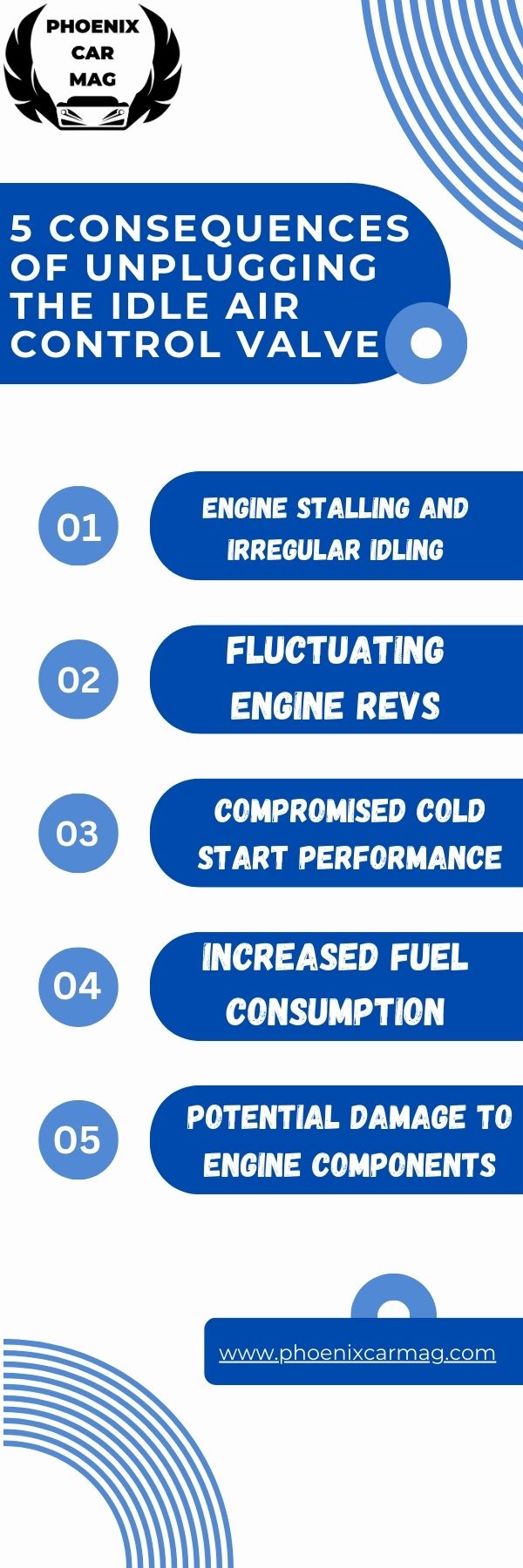
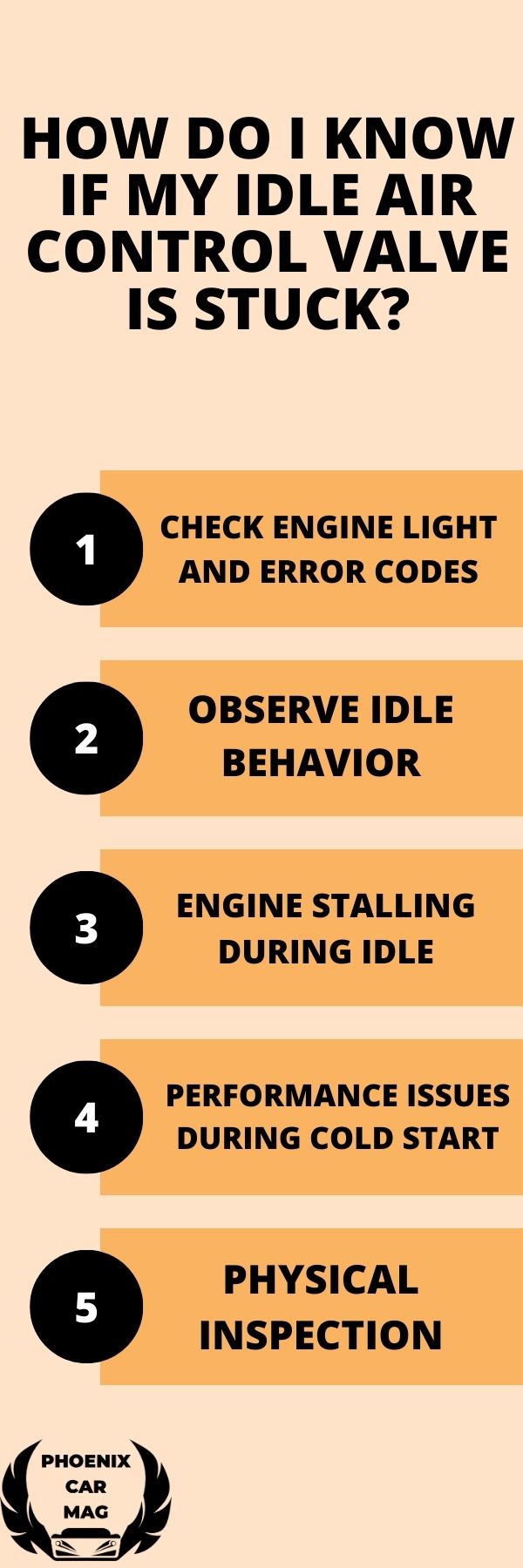
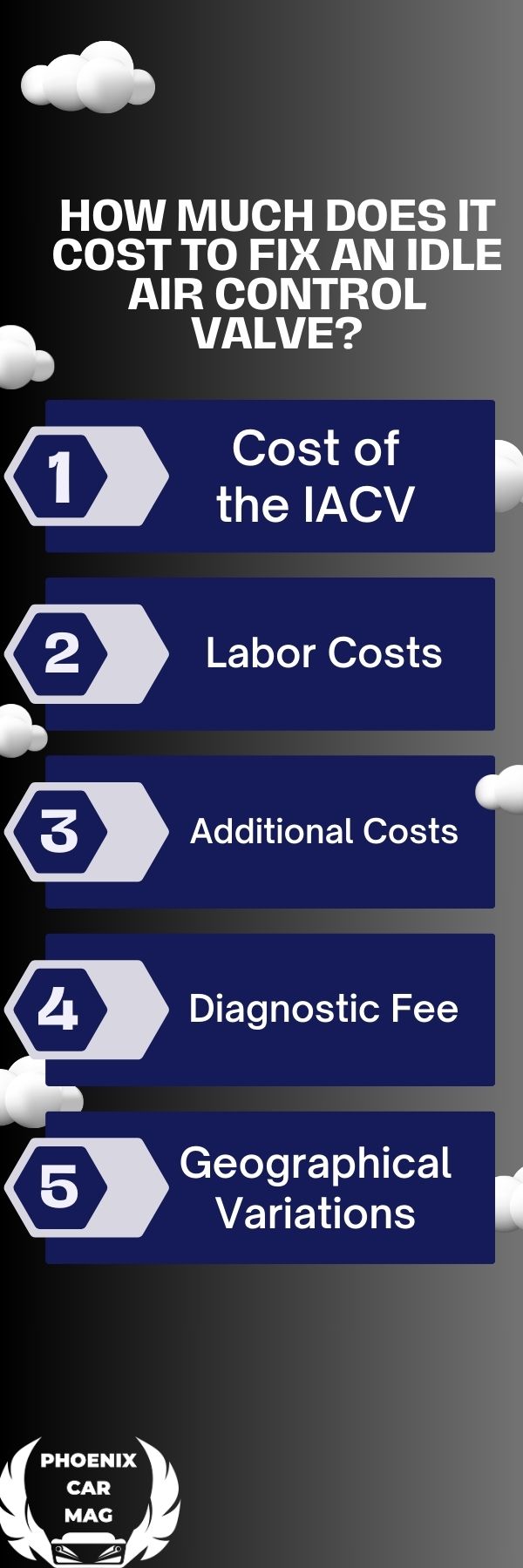

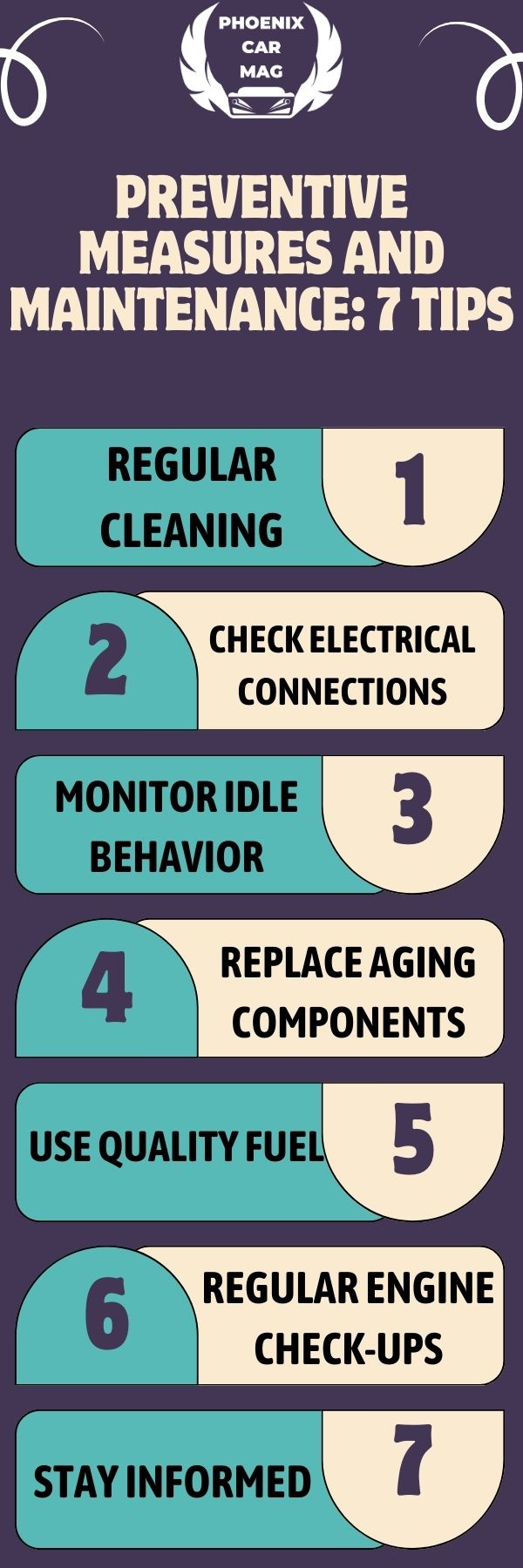
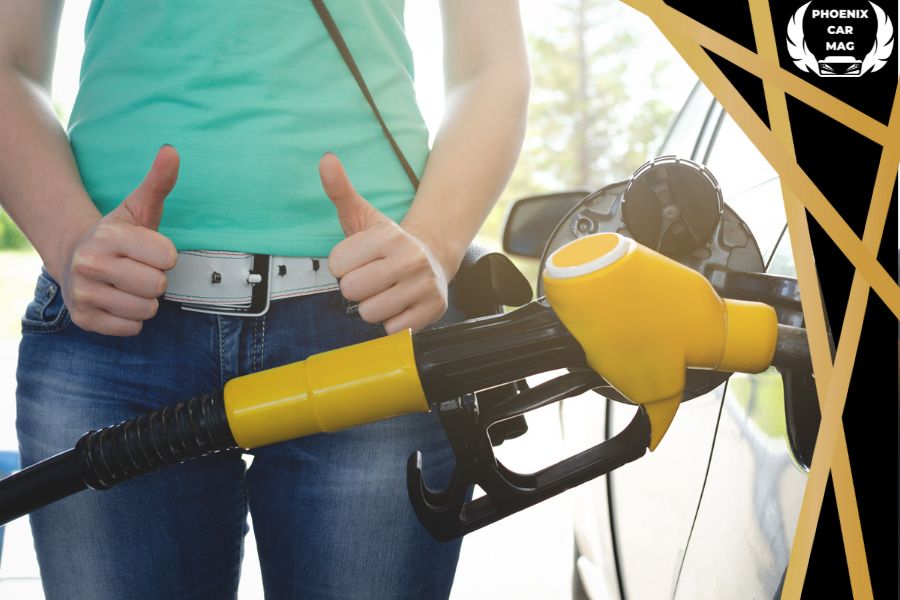


![Brake Fluid Change: Costs + Signs + Everything [2024]](https://phoenixcarmag.com/wp-content/uploads/2024/01/Brake-Fluid-Change-Costs-Signs-Everything-2024-2-308x180.jpg)
